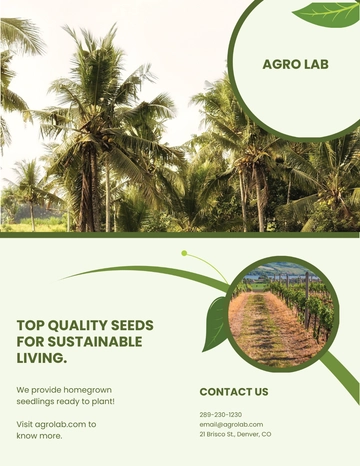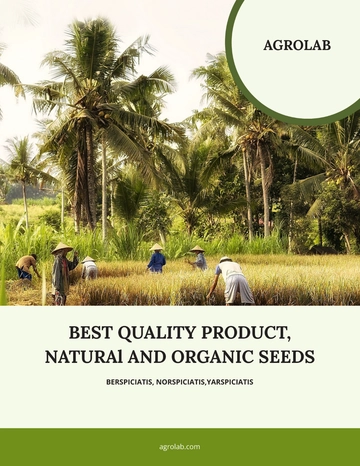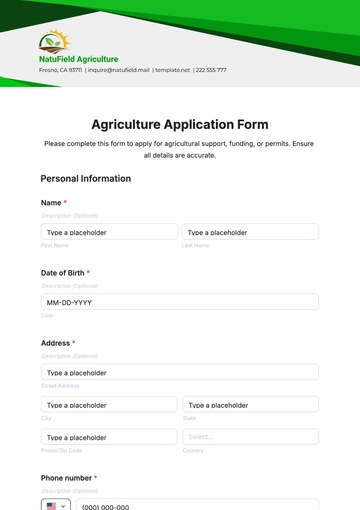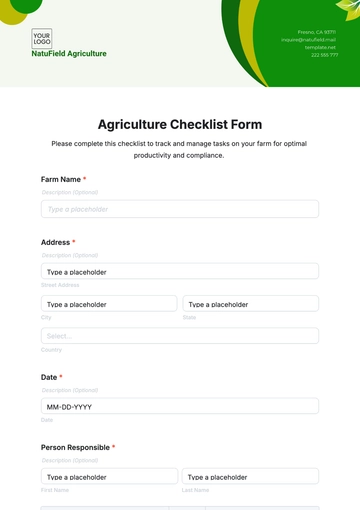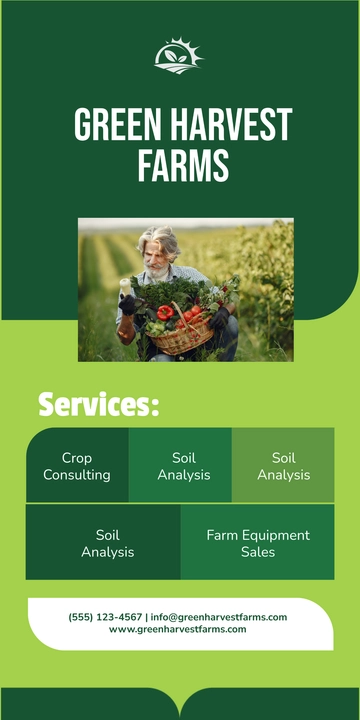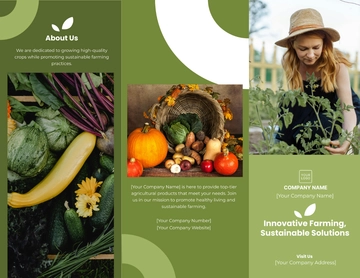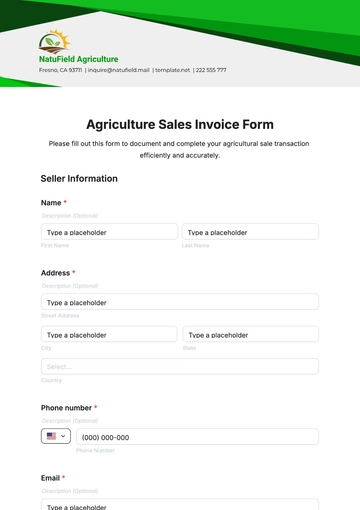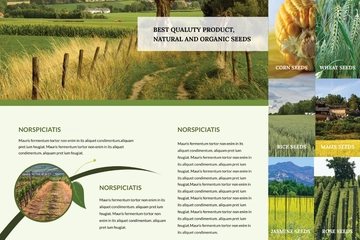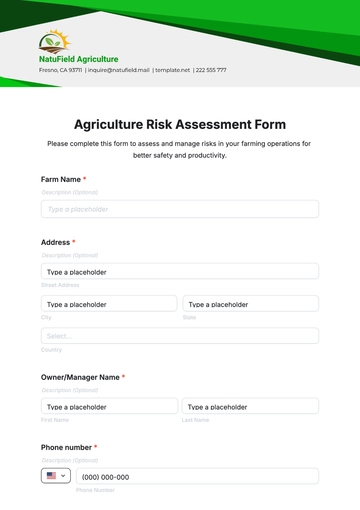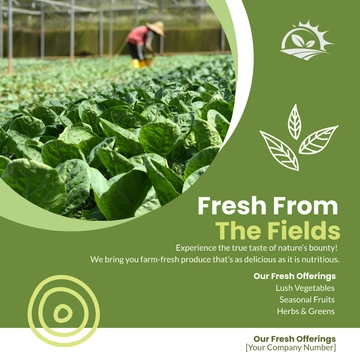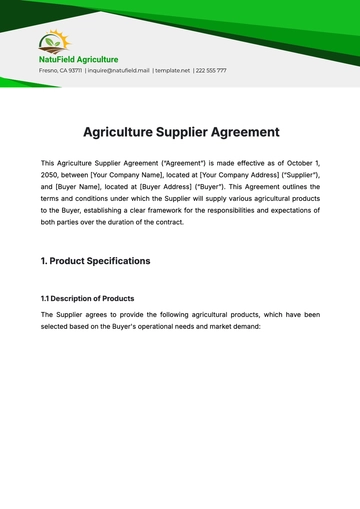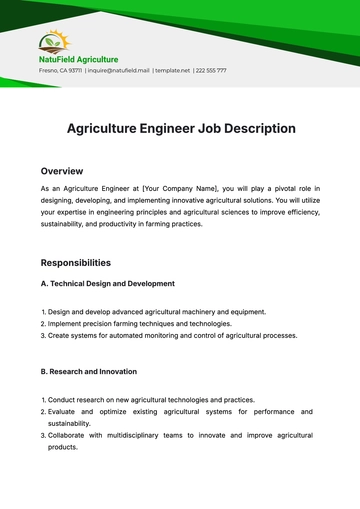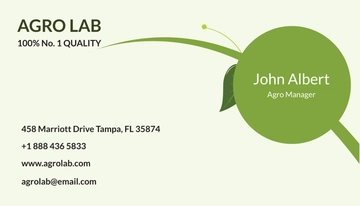Free Agriculture Investment Feasibility Study
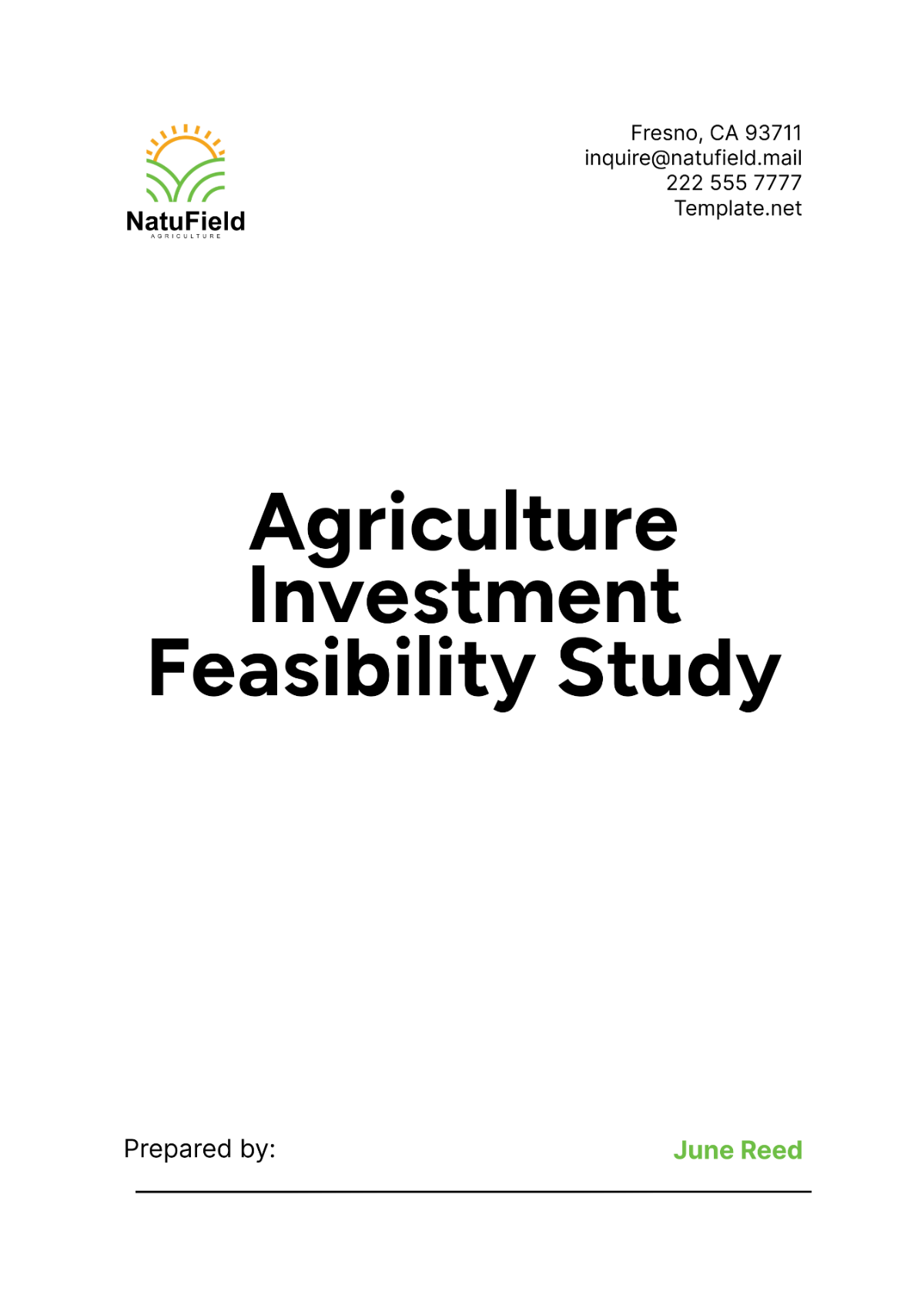
I. Executive Summary
This feasibility study evaluates the potential investment in expanding [Your Company Name]'s agricultural operations to include a new crop variety, specifically organic strawberries. The study aims to determine the financial viability, market potential, and operational requirements of this investment.
Key financial projections indicate that the total initial investment required is $2,500,000, with an expected annual revenue of $1,200,000 starting in the second year. The projected return on investment (ROI) over a five-year period is 25%, with a break-even point anticipated in the third year. These projections are based on detailed cost analysis, market research, and revenue forecasts.
The market analysis suggests a growing demand for organic produce, with strawberries being one of the top sought-after fruits. Consumer trends indicate a shift towards healthier, organic options, providing a significant opportunity for [Your Company Name] to capitalize on this market segment. This study also considers the operational aspects, including land preparation, labor requirements, and technology adoption, to ensure the successful implementation of the project.
II. Market Analysis
A. Market Demand
Consumer Trends: Recent consumer trends indicate a growing preference for organic produce due to health and environmental concerns. Organic strawberries are particularly popular among health-conscious consumers.
Market Size: The market for organic produce is expanding rapidly. The demand for organic strawberries has seen an annual growth rate of 8%, indicating a robust market potential.
Competitor Analysis: Analyze key competitors in the organic strawberry market. Understand their strengths, weaknesses, and market positioning to identify potential opportunities for differentiation.
Supply Chain Dynamics: Evaluate the supply chain for organic strawberries. Identify key suppliers, distribution channels, and potential bottlenecks to ensure a smooth supply chain operation.
Pricing Trends: Analyze the pricing trends for organic strawberries. Understanding the price elasticity and consumer willingness to pay a premium for organic products is crucial for setting competitive pricing strategies.
B. Target Market
The following chart and table present the target market segments for organic strawberries and the potential revenue:
Market Segment | Description | Potential Revenue |
|---|---|---|
Health-Conscious Consumers | Individuals prioritizing organic, healthy food | $500,000 |
Specialty Grocery Stores | Retailers focusing on organic produce | $300,000 |
Farmers Markets | Direct-to-consumer sales at local markets | $200,000 |
Online Retailers | E-commerce platforms for organic products | $200,000 |
Total | $1,200,000 |
Health-Conscious Consumers: This segment represents individuals who prioritize organic and healthy food options. With increasing awareness of the benefits of organic produce, this segment offers significant revenue potential of $500,000.
Specialty Grocery Stores: These retailers focus on organic produce and cater to consumers seeking high-quality, specialty food items. This segment is projected to generate $300,000 in revenue.
Farmers Markets: Direct-to-consumer sales at local farmers markets provide an opportunity to engage with consumers and build brand loyalty. This segment is expected to contribute $200,000 to the total revenue.
Online Retailers: E-commerce platforms for organic products offer a convenient shopping option for consumers. This segment is projected to generate $200,000 in revenue.
Understanding the target market is essential for developing effective marketing strategies and ensuring the successful commercialization of organic strawberries. By focusing on these key segments, [Your Company Name] can maximize its market reach and revenue potential.
III. Financial Analysis
A. Cost Breakdown
The following table presents the detailed cost breakdown for the initial investment:
Cost Component | Amount |
|---|---|
Land Acquisition | $500,000 |
Land Preparation | $300,000 |
Seeds and Plants | $200,000 |
Irrigation System | $400,000 |
Labor Costs | $300,000 |
Technology and Equipment | $400,000 |
Marketing and Sales | $200,000 |
Miscellaneous Expenses | $200,000 |
Total | $2,500,000 |
Land Acquisition: Acquiring suitable land for organic strawberry cultivation is estimated to cost $500,000. This includes purchasing fertile land with the necessary attributes for organic farming.
Land Preparation: Preparing the land involves soil testing, nutrient management, and other preparatory activities. This is projected to cost $300,000.
Seeds and Plants: Purchasing high-quality organic strawberry seeds and plants is essential for ensuring a successful yield. This cost is estimated at $200,000.
Irrigation System: Installing an efficient irrigation system is crucial for maintaining optimal moisture levels and supporting plant growth. This investment is projected to cost $400,000.
Labor Costs: Hiring skilled labor for planting, maintenance, and harvesting is estimated to cost $300,000.
Technology and Equipment: Investing in modern technology and equipment, such as automated harvesting systems, is essential for operational efficiency. This cost is projected at $400,000.
Marketing and Sales: Effective marketing and sales strategies are necessary to promote the organic strawberries and reach target consumers. This is estimated to cost $200,000.
Miscellaneous Expenses: Additional expenses, including contingency funds, are projected to be $200,000.
A detailed cost analysis is critical for ensuring the financial viability of the investment. By understanding the various cost components, [Your Company Name] can allocate resources effectively and manage expenses to achieve profitability.
B. Revenue Projections
The following chart and table present the revenue projections for the first five years:
Year | Revenue |
|---|---|
1 | $600,000 |
2 | $1,200,000 |
3 | $1,300,000 |
4 | $1,400,000 |
5 | $1,500,000 |
Year 1: The projected revenue for the first year is $600,000. This reflects initial market entry and the gradual build-up of consumer awareness and demand for organic strawberries.
Year 2: Revenue is expected to double to $1,200,000 in the second year, driven by increased market penetration and consumer acceptance.
Year 3: Continued marketing efforts and expansion into new market segments are projected to result in revenue growth to $1,300,000 in the third year.
Year 4: Revenue is expected to increase to $1,400,000 in the fourth year, reflecting sustained demand and market growth.
Year 5: By the fifth year, revenue is projected to reach $1,500,000, driven by brand loyalty, repeat customers, and further market expansion.
The revenue projections indicate a positive growth trend, demonstrating the financial viability of the investment. Effective marketing strategies and continuous market expansion are crucial for achieving these revenue targets.
IV. Operational Requirements
A. Land and Infrastructure
Land Selection: Select fertile land with the necessary attributes for organic farming, including soil quality, water availability, and climate conditions.
Land Preparation: Conduct soil testing and nutrient management to prepare the land for organic strawberry cultivation. Implement sustainable farming practices to maintain soil health.
Irrigation System: Install an efficient irrigation system to ensure optimal moisture levels for the strawberry plants. Consider drip irrigation for water conservation and efficient water use.
Greenhouse Construction: Consider constructing greenhouses to extend the growing season and protect plants from adverse weather conditions. This ensures a consistent supply of strawberries.
Storage Facilities: Build storage facilities to store harvested strawberries under optimal conditions. This reduces spoilage and maintains product quality.
B. Labor and Workforce
Labor Requirements: Determine the labor requirements for planting, maintenance, and harvesting. Hire skilled labor with experience in organic farming practices.
Training Programs: Implement training programs to educate the workforce on organic farming techniques, safety protocols, and efficient harvesting methods.
Labor Management: Develop labor management strategies to ensure efficient allocation of tasks and optimal productivity. Implement performance monitoring and evaluation systems.
Health and Safety: Ensure compliance with health and safety regulations to protect the workforce. Provide necessary safety equipment and training.
Seasonal Labor: Consider hiring seasonal labor during peak harvesting periods to meet increased labor demands. Plan for labor availability and manage labor costs effectively.
C. Technology and Equipment
Automated Harvesting Systems: Invest in automated harvesting systems to increase efficiency and reduce labor costs. These systems can enhance productivity and ensure timely harvesting.
Irrigation Technology: Implement advanced irrigation technology, such as soil moisture sensors and automated irrigation systems, to optimize water use and plant growth.
Pest Management: Use integrated pest management (IPM) techniques to control pests and diseases. This includes biological control methods and organic pesticides.
Monitoring Systems: Install monitoring systems to track plant health, soil conditions, and weather patterns. This data can inform decision-making and improve crop management.
Processing Equipment: Invest in processing equipment to wash, sort, and package strawberries. This ensures product quality and reduces post-harvest losses.
D. Supply Chain and Distribution
Supply Chain Management: Develop a robust supply chain management strategy to ensure the timely delivery of raw materials, equipment, and other supplies. Establish relationships with reliable suppliers.
Distribution Channels: Identify and establish distribution channels for the organic strawberries. This includes direct-to-consumer sales, partnerships with retailers, and online platforms.
Logistics: Implement efficient logistics solutions to transport strawberries from the farm to the market. Ensure timely delivery and maintain product quality during transit.
Inventory Management: Develop inventory management systems to track stock levels and manage supply and demand. This reduces waste and ensures a consistent supply of strawberries.
Quality Control: Implement quality control measures to ensure the strawberries meet the required standards. This includes regular inspections and adherence to organic certification requirements.
V. Risk Analysis
A. Financial Risks
Market Fluctuations: Monitor market fluctuations and consumer demand for organic strawberries. Implement strategies to manage price volatility and maintain profitability.
Funding Challenges: Secure sufficient funding for the initial investment and ongoing operations. Explore various funding options, including loans, grants, and investor partnerships.
Cost Overruns: Implement cost control measures to prevent cost overruns during the project implementation. Regularly review budgets and expenses to ensure financial stability.
Revenue Shortfalls: Develop contingency plans to address potential revenue shortfalls. This includes diversifying revenue streams and exploring new market opportunities.
B. Operational Risks
Weather Conditions: Monitor weather conditions and implement strategies to mitigate the impact of adverse weather on crop yield. Consider using greenhouses and irrigation systems.
Pest and Disease Management: Implement integrated pest management (IPM) techniques to control pests and diseases. Regularly monitor plant health and take preventive measures.
Labor Shortages: Develop strategies to address potential labor shortages during peak periods. This includes hiring seasonal labor and implementing labor management systems.
Equipment Failures: Maintain and regularly inspect equipment to prevent breakdowns. Implement preventive maintenance programs to ensure operational efficiency.
C. Legal and Compliance Risks
Regulatory Compliance: Ensure compliance with all relevant regulations and standards for organic farming. Regularly review and update policies to adhere to regulatory changes.
Land Use and Zoning: Verify land use and zoning regulations to ensure the selected land is suitable for organic strawberry cultivation. Obtain necessary permits and approvals.
Organic Certification: Obtain organic certification for the strawberries to meet market demand and maintain consumer trust. Ensure compliance with certification requirements.
Intellectual Property: Protect intellectual property related to farming techniques, technology, and brand. Secure patents and trademarks as necessary.
D. Reputational Risks
Product Quality: Maintain high standards of product quality to meet consumer expectations. Implement quality control measures and regular inspections.
Customer Satisfaction: Monitor customer satisfaction and address any complaints promptly. Implement feedback mechanisms to improve products and services.
Brand Image: Develop and maintain a positive brand image through effective marketing and communication strategies. Engage with consumers and build brand loyalty.
Public Relations: Implement public relations strategies to manage the company's reputation. This includes addressing negative publicity and promoting positive stories.
VI. Environmental Impact
A. Sustainable Farming Practices
Soil Health: Implement sustainable farming practices to maintain soil health. This includes crop rotation, cover cropping, and organic fertilizers.
Water Conservation: Use efficient irrigation systems and water management techniques to conserve water resources. Implement rainwater harvesting and recycling systems.
Biodiversity: Promote biodiversity on the farm by planting a variety of crops and maintaining natural habitats. This supports ecosystem health and pest control.
Energy Efficiency: Implement energy-efficient practices and renewable energy sources to reduce the farm's carbon footprint. This includes solar panels and energy-efficient equipment.
Waste Management: Develop waste management systems to reduce, reuse, and recycle farm waste. Implement composting and waste-to-energy initiatives.
B. Compliance with Environmental Regulations
Regulatory Compliance: Ensure compliance with environmental regulations and standards. Regularly review and update policies to adhere to regulatory changes.
Environmental Impact Assessments: Conduct environmental impact assessments to evaluate the potential impact of farming activities. Develop mitigation strategies to minimize negative impacts.
Certification: Obtain environmental certifications, such as organic certification and sustainable agriculture certification. Ensure compliance with certification requirements.
Community Engagement: Engage with the local community to address environmental concerns and promote sustainable practices. Implement community outreach programs and education initiatives.
VII. Technological Considerations
A. Advanced Farming Techniques
Precision Agriculture: Implement precision agriculture techniques, such as GPS mapping and data analytics, to optimize crop management. This improves yield and reduces resource use.
Automation: Invest in automation technology, such as automated planting and harvesting systems, to increase efficiency and reduce labor costs.
IoT and Sensors: Use Internet of Things (IoT) devices and sensors to monitor soil conditions, weather patterns, and plant health. This data informs decision-making and improves crop management.
Drones: Use drones for aerial monitoring and surveying of crops. This provides valuable data on plant health, growth patterns, and potential issues.
Blockchain: Implement blockchain technology to ensure traceability and transparency in the supply chain. This builds consumer trust and enhances product authenticity.
B. Research and Development
Crop Research: Invest in research and development to improve crop varieties and farming techniques. Collaborate with research institutions and universities.
Technology Partnerships: Develop partnerships with technology providers to access the latest farming technology and equipment. This ensures the farm remains at the forefront of innovation.
Pilot Programs: Implement pilot programs to test new technologies and farming methods. This allows for experimentation and refinement before full-scale implementation.
Data Analytics: Use data analytics to analyze farm data and identify trends and opportunities for improvement. This supports data-driven decision-making.
Innovation Grants: Apply for innovation grants and funding opportunities to support research and development initiatives. This provides financial support for technological advancements.
VIII. Recommendations
A. Strategic Initiatives
Market Expansion: Focus on expanding market reach by targeting new consumer segments and exploring new distribution channels. This includes direct-to-consumer sales and online platforms.
Product Diversification: Diversify product offerings by exploring additional organic produce varieties. This reduces risk and increases revenue potential.
Sustainability: Implement sustainable farming practices to enhance environmental performance and meet consumer demand for eco-friendly products. This includes water conservation and waste management.
Technology Adoption: Invest in advanced farming technology to improve operational efficiency and productivity. This includes precision agriculture, automation, and IoT devices.
Brand Development: Develop a strong brand identity for the organic strawberries. This includes effective marketing and communication strategies to build brand loyalty and consumer trust.
B. Financial Strategies
Funding Options: Explore various funding options to secure sufficient capital for the initial investment and ongoing operations. This includes loans, grants, and investor partnerships.
Cost Management: Implement cost control measures to manage expenses and prevent cost overruns. Regularly review budgets and expenses to ensure financial stability.
Revenue Diversification: Diversify revenue streams by exploring additional market opportunities and product offerings. This reduces risk and increases financial resilience.
Financial Monitoring: Develop financial monitoring systems to track performance and identify potential issues. This includes regular financial reviews and performance evaluations.
Investment Review: Regularly review and adjust the investment strategy to ensure alignment with business goals and changing market conditions. This ensures continuous improvement and financial success.
IX. Conclusion
This Agriculture Investment Feasibility Study of [Your Company Name] demonstrates the potential for a successful investment in organic strawberry cultivation. The study highlights key financial projections, market potential, and operational requirements, providing a comprehensive analysis of the investment opportunity.
By implementing the recommended strategies and initiatives, [Your Company Name] can capitalize on the growing demand for organic produce and achieve long-term business success. Continuous monitoring and adaptation of these strategies will ensure the company remains competitive and sustainable in the dynamic agricultural industry.
- 100% Customizable, free editor
- Access 1 Million+ Templates, photo’s & graphics
- Download or share as a template
- Click and replace photos, graphics, text, backgrounds
- Resize, crop, AI write & more
- Access advanced editor
Evaluate investment opportunities with our Agriculture Investment Feasibility Study Template from Template.net! This template provides editable fields to customize the study to your needs. Customizable sections enable you to incorporate specific analysis details. The AI Editor Tool ensures efficient and accurate feasibility study creation, tailored to your agricultural investment evaluations!
